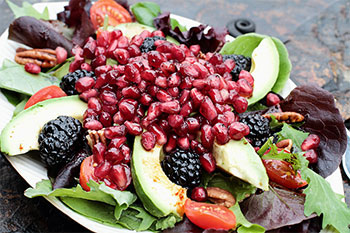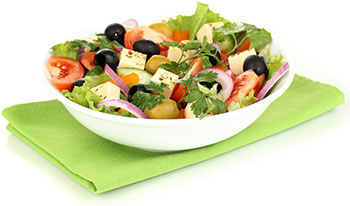Adjusting to Gluten Free
 If you have a gluten intolerance, gluten must be completely avoided. Even small gluten traces can cause symptom flare-ups. If other members of your household eat gluten, it's also important to use a separate cutting board, kitchen utensils, toaster, and area of the counter to prepare your food. If food items are packaged in the same facility as gluten products, you may also experience flare-ups.
If you have a gluten intolerance, gluten must be completely avoided. Even small gluten traces can cause symptom flare-ups. If other members of your household eat gluten, it's also important to use a separate cutting board, kitchen utensils, toaster, and area of the counter to prepare your food. If food items are packaged in the same facility as gluten products, you may also experience flare-ups.
If you have a gluten sensitivity, your body will react to gluten with much less severity and you do not have to be as restrictive. Simply cutting out products containing gluten is sufficient. If the products were made in a factory which also processes other products containing gluten, you will likely experience no symptoms. If you purchase a food where one the trace ingredients may contain gluten, you will also likely experience no symptoms.
Gluten Here, There & Everywhere!
Giving up gluten may sound as basic as cutting out pasta and bread, but the presence of gluten is much more far-reaching. In fact, it is found hidden under unassuming names in the ingredient lists of thousands of packaged food. Because gluten makes foods thick and tasty, it is found in many products ranging from breads and crackers to salad dressings and soy sauce, soups, condiments and many low/non fat products. In fact, it is difficult to find a food group where manufacturers don't use it.
Going gluten free means becoming much more aware of what you are putting into your mouth. It involves looking at food labels very carefully. It's not a simple task because food manufacturers are not required by law to identify ALL possible sources of gluten on their product labels, so reading the label may not be enough. Hidden gluten sources include:
- Malts
- Starches
- Hydrolyzed vegetable protein (HVP)
- Texturized vegetable protein (TVP)
- Natural flavoring
A gluten-free diet means avoiding all products that contain wheat, rye and barley, or any of their derivatives. Common favorites that are not clearly marked as gluten-free include:
- Bread / Flatbread / Pita / Bagels / Croissants
- Phyllo Desserts (Baklava)
- Cookies / Brownies / Muffins / Pastries
- Pasta / Lasagna
- Pizza
- Croutons
- Breaded Foods / Breadcrumbs
- Beer
- Cereals
- Crackers / Pretzels / Wafers
- Some chocolates
- Sandwichs / Wraps / Burritos
Because it can be difficult to understand which ingredients on an ingredient list contain gluten and which don't, unless a product is clearly labeled as "gluten free," many gluten free individuals throw their hands up and simply purchase and eat fresh produce and meats. As a result, their diet is much healthier than the average American and in the long run, they feel and look so much better than they never did on their old diet.
Unexpected Sources of Gluten
It's not just food items that contain gluten. Many other products such as toothpaste, lipsticks, make-up, medications, vitamins and other supplements, may also contain traces of gluten.
Gluten-Free Foods & Manufacturers
Ok... before you decide you may as well just go and crawl under a rock because your days of eating yummy foods are over, going gluten free today is a piece of cake! (gluten free cake, of course). So, what exactly does that leave to eat on a gluten free diet. Actually, many delicious and healthy items!
- All veggies
- All fruits
- All nuts and seeds
- Eggs (make it organic, and free range)
- Legumes - all lentils, peas, and beans including soybeans (eat them whole, never eat processed soy - think "edamame")
- All meats and fish (make it organic and pasture-raised) - just watch out for the sauces, broths, seasonings and the marinades!
- Many grains, including quinoa, rice, and buckwheat (buckwheat noodles are delicious!)
If you love desserts, check out one of the many raw food dessert "uncook books" that are filled with yummy recipes made with fruits and nuts, blended into all sorts of tasty combinations. In fact, some of the crusts (think crushed almonds, macadamia nuts, coconut oil, and vanilla beans) taste far better than any of the store bought graham cracker crusts that I've ever had.
Thanks to the increase in individuals diagnosed celiac and gluten sensitivity, there are now many "gluten-free" foods which have emerged in supermarkets and health food stores. Even restaurants are now offering gluten free menu items. Some stores even have entire sections dedicated to gluten-free products. Whereas some gluten-free products still leave much to be desired on the "yummy" scale, there are now a sizable number of very tasty and healthy gluten-free products on the market.
Gluten Free Doesn't Necessarily Mean Healthier
 As with any diet, if we are not educated on what comprises nutritionally dense foods, a gluten-free diet can quickly become another version of the nutritionally deficient standard American processed diet. When we remove whole grain foods from the diet and replace them with gluten-free cookies and cakes and brownies, highly processed and heavy in fat and sugar and devoid of the nutrition our body needs, then we will run into trouble. There are many gluten-free food item I've picked up, only to read the ingredient label and return it to the shelf in horror.
As with any diet, if we are not educated on what comprises nutritionally dense foods, a gluten-free diet can quickly become another version of the nutritionally deficient standard American processed diet. When we remove whole grain foods from the diet and replace them with gluten-free cookies and cakes and brownies, highly processed and heavy in fat and sugar and devoid of the nutrition our body needs, then we will run into trouble. There are many gluten-free food item I've picked up, only to read the ingredient label and return it to the shelf in horror.
Food companies are always trying to take advantage of the latest dietary trend or health craze, but don't assume they do it out of the goodness of their hearts or because they care about our health. Gluten-free is a multi-Billion dollar business, with profits expected to exceed of $6.2 billion by 2018. Companies such as General Mills, Frito-Lay, Kellogg, and even Anheuser-Busch quickly jumped on the bandwagon, reformulating many favorite foods and drinks to be gluten-free. Many have no part in a healthy, nutritious diet.
Gluten Free & High-Fat, High-Sugar Foods
Assuming you'll lose weight on a gluten-free diet can easily backfire if you aren't careful, because gluten-free doesn't mean it's low on calories or fat. Without gluten to "bind" the food together and give it a light and airy texture, food manufacturers often use more fat, sugar, and other unhealthy ingredients to make the food look and taste exciting. In fact, many gluten-free foods are loaded with a long list of unhealthy ingredients. Many of the substitutes used in gluten-free foods are nutritionally inferior and devoid of important nutrients such as fiber, iron, folate, thiamine, niacin, riboflavin, phosphorus, and zinc. To add insult to injury, they are often higher in fat and calories.
Gluten Free Grains, Flours & Starches
Although it might seem like having a wheat allergy or gluten intolerance limits many things you can eat, the truth is there are many things that are safe to eat too. The foundation of both wheat-free and gluten-free diets is fruits, vegetables, plant proteins (such as legumes and beans) and lean meats and fish.
Certain gluten free grains or legumes can be cross-contaminated with other gluten grains during the manufacturing process, and therefore still be dangerous even though they are technically being gluten-free. Individual with celiac disease can experience adverse reactions to these products. Pay close attention to whether the food label states whether or not the product has been prepared in a facility that contains gluten.
It can be challenging to know the difference between grains, flours and starches that contain gluten, and that don't. Foods made with flours such as coconut or almond, are great examples of flours that are both gluten and wheat free.
|
Gluten Free
|
Contains Gluten or Wheat
|
|
| Amaranth Arrowroot Beans Black Gram Buckwheat Chickpea (Besan) Corn Garbanzo Garfava Lentil Maize Millet Montina Nut Flours (e.g. almond or coconut) Pea Pinto Potato starch/flour Quinoa Rice/rice flours Sorghum Soy Sweet Potato Tapioca (Manioc) Teff |
Barley* Bran Bulgur Couscous Durum Einkorn Emmer Farina Faro Graham Matzoh Meal Oats** Rye Semolina Wheat Germ Sprouted and fermented wheat Wheat Starch |
|
* Including malt vinegars, malted milk drinks and candies, and brown rice syrup made with rice malt and beer.
** Some studies show that most people with celiac disease can tolerate oats, but others show sensitivity. Recent studies suggest that contamination from other gluten products may be the issue.



